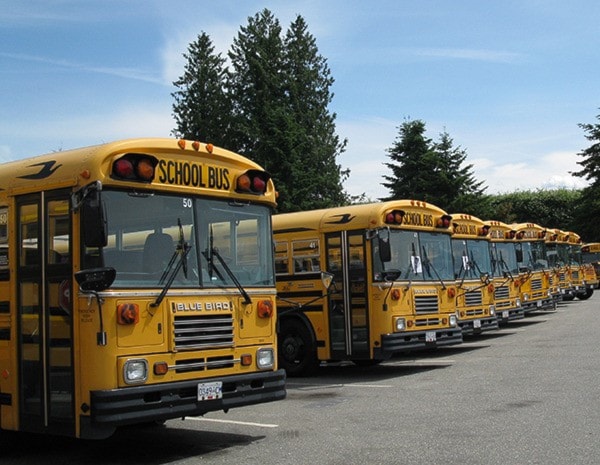The Abbotsford school district will hike bus fees and reduce transportation services in the face of a $4 million budget shortfall, administrators told around 100 people at a public meeting Wednesday at W.J. Mouat secondary.
Riders taking the bus to district programs will see their fees dramatically increased, from $300 per student or $500 per family, to $600/student or $800/family. Those who take the bus to their local catchment school will pay $400/student or $600/family, a $100 increase in both cases. The district buses nearly 2,800 students each day.
Superintendent Kevin Godden said the board had to look at what cuts could be made with the least impact on classroom learning as it attempted to overcome a projected deficit of $4 million. With no provincial funding for transportation, bus services pose a significant drain on the district’s coffers, administrators told parents. This school year, transportation cost the district $3 million, with only $446,975 collected in fees.
A recent study showed that the majority of buses are less than half-full, while around 1,000 riders take the bus despite living within walk-limits meant to determine eligibility for bus service. The district hopes that increased efficiencies and the higher fees can reduce the net cost by $400,000.
Currently, secretary-treasurer Ray Velestuk told parents “what we have is a system that is accommodating the demand but sacrificing efficiency.”
As part of the cuts, the district will stop operating routes that currently provide service to students who have chosen to attend a school outside their catchment area, but who don’t attend a district program like French Immersion that draws its students from the entire city. That is expected to affect 125 to 175 students.
Walk limits will be altered, from four to 3.2 kilometres for elementary school students and from 4.8 to four kilometres for middle and secondary students. The presence of hazardous crossings and other factors are also considered when determining eligibility for service. If space on buses permits, the district will continue to provide service to students living within the limits, although Velestuk says the district expects that the increased fees will cause some to walk to school instead.
Going forward, though, parents were cautioned more cuts could be made.
In passing its budget Tuesday, the district made several other cuts to trim its deficit to around $800,000 this year. To cover the deficit, the district will dip into its accumulated surplus, which is expected be reduced to just above $7 million.
The district also slashed the budgets for discretionary funding by schools and district departments for supplies ($1 million cut) and professional development ($280,000 cut).
Reductions in staffing, including for substitute employees, management positions, and teacher salaries will also save the district around $1.4 million.
Those cuts will be countered by expansions elsewhere as the district predicts 180 more students, plus 30 to 40 new international students, attending class in the fall. The district will also be investing $8 million in classroom technology over the next four years.
